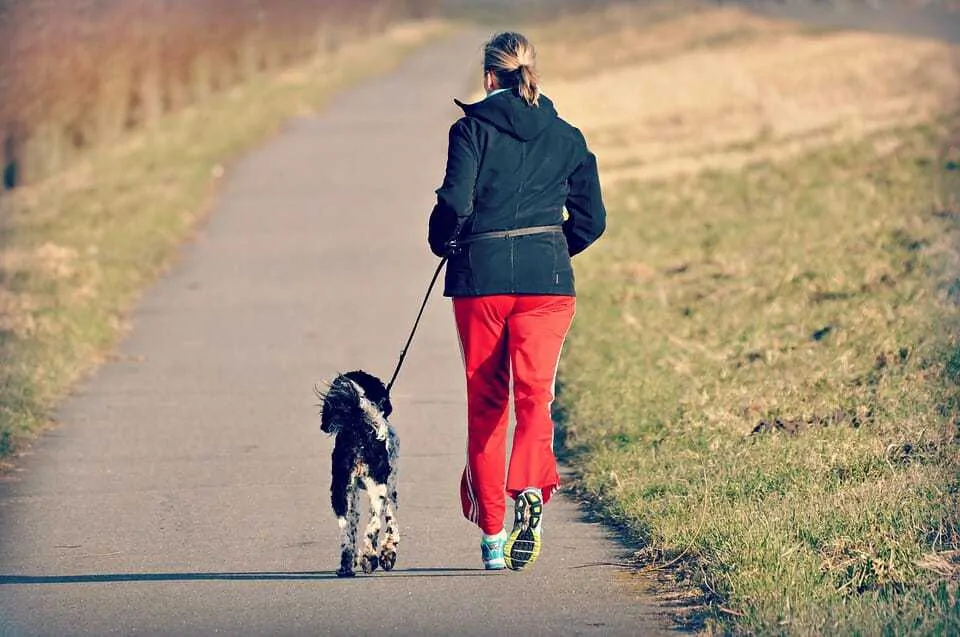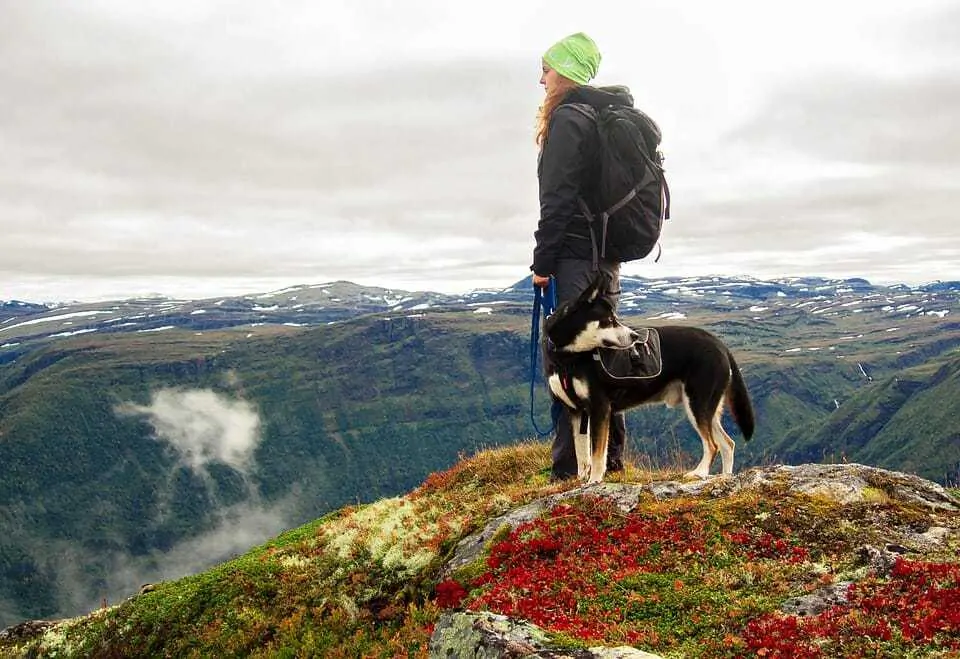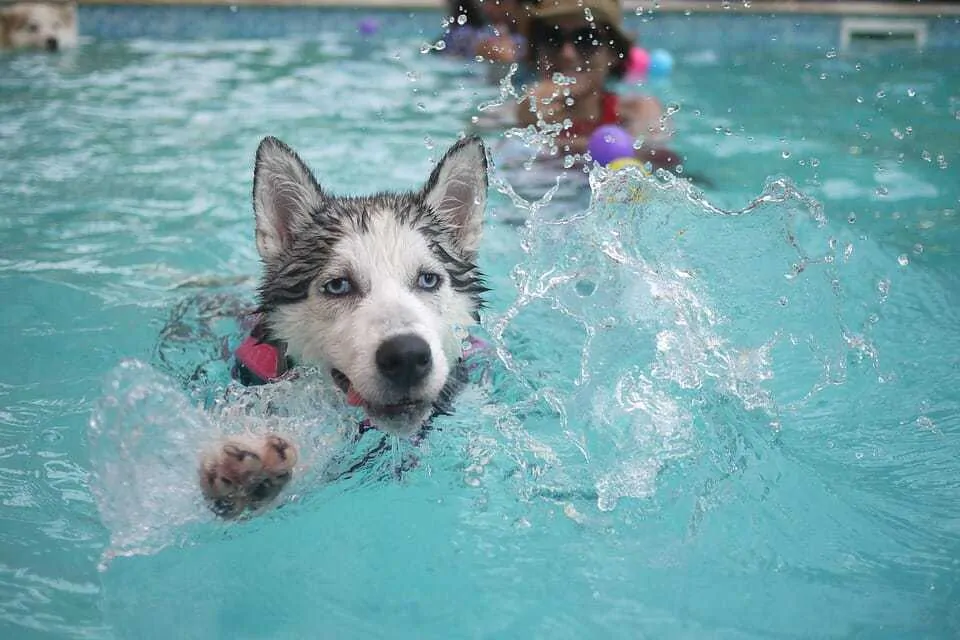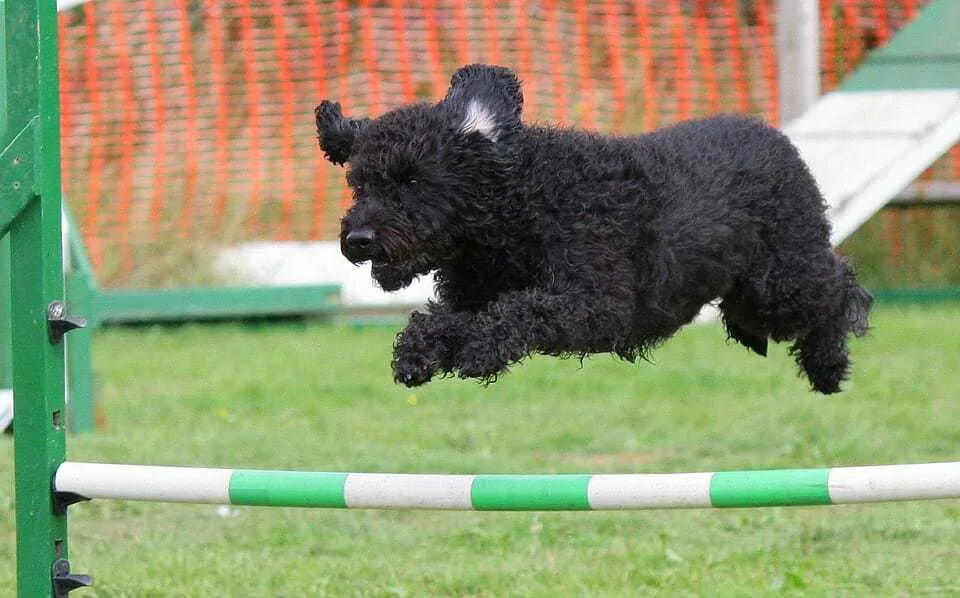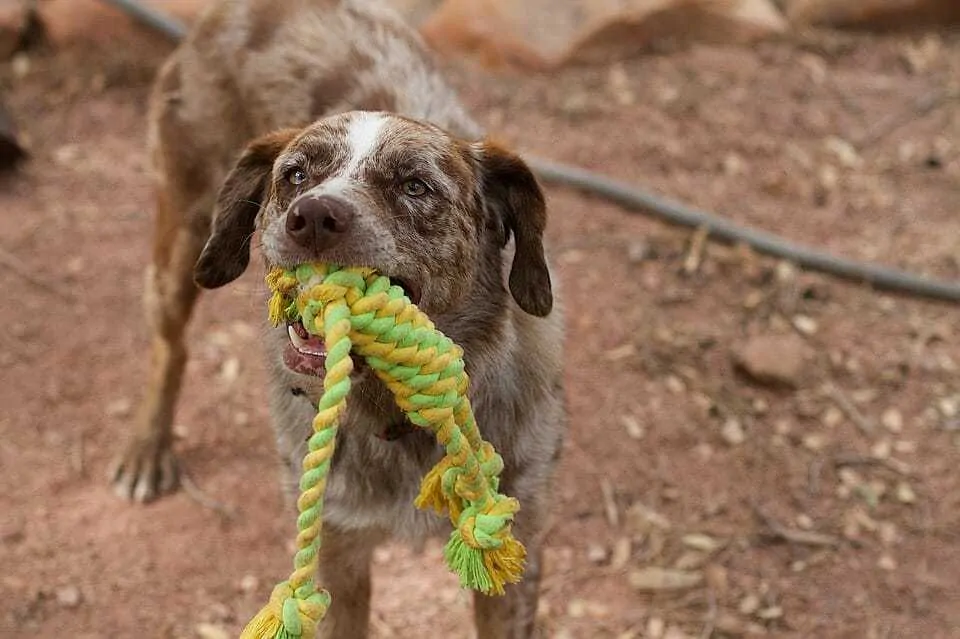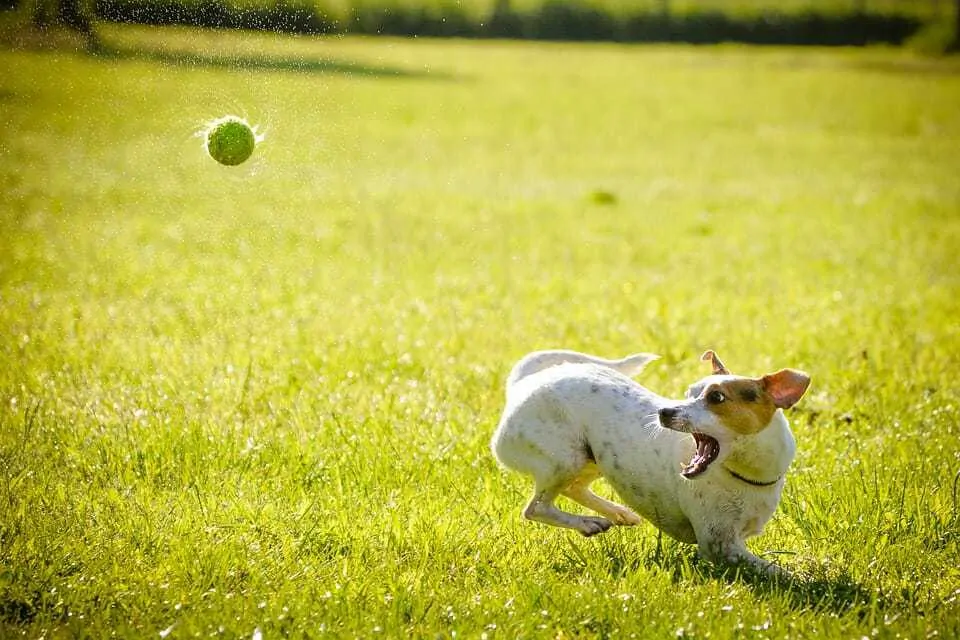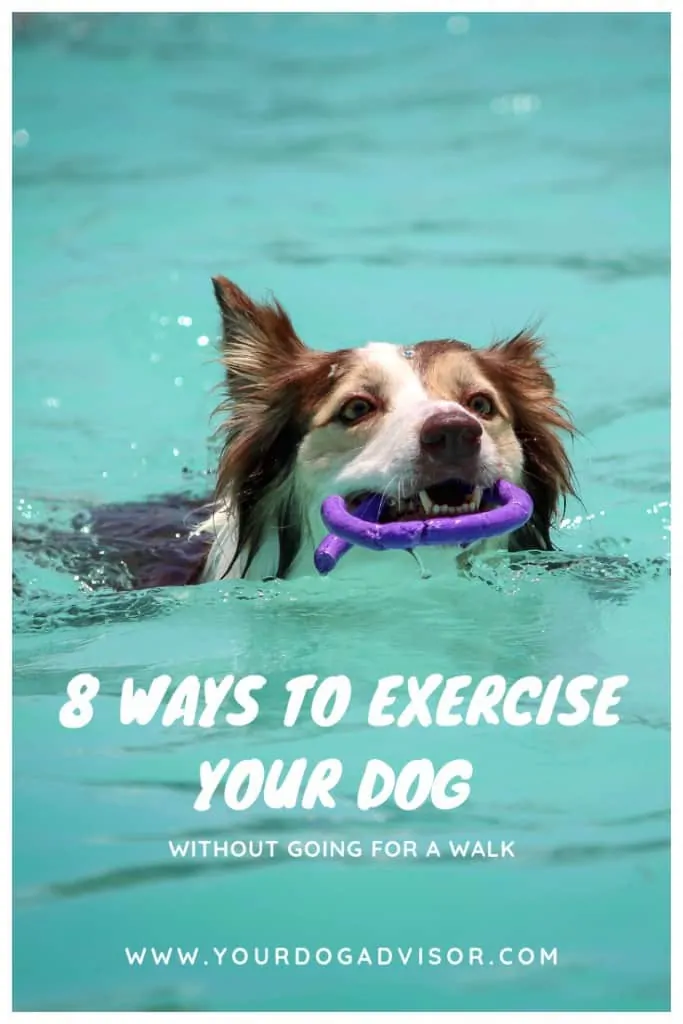Regular dog walks are very important for your dog, both physically and mentally. Sometimes a dog may need more than just a couple of regular walks a day to keep them from becoming bored.
Sometimes other options for exercise may be required for a variety of other reasons too. These could include your dog recovering from an injury, being unable to interact with other dogs because of a viral illness or reactivity, to help with weight loss or because of extreme weather conditions or temporary owner incapacity.
Sometimes it can just be as simple as it being an activity that your dog loves to do, so why not let them indulge in their passion! If you are able to find something that appeals to both of your passions it will be something that you can bond over and you will be equally as enthusiastic about enjoying it together.
Whatever activity you choose it is always a good idea to build up any increased exercise gradually. Like us, dog’s fitness levels will vary and you don’t want to cause injury by expecting too much, too soon.
While regular dog walks are important for your dog, it is not the only beneficial way for them to get some exercise
Contents
Don’t Forget to Consider Your Dog’s Capabilities
When considering other exercise options, it is important to take into consideration your dog’s age, weight, any other potential health conditions and their temperament.
Puppies
Don’t forget that puppies have softer, growing bones and too much exercise or activities that are high impact can cause long term musculoskeletal damage. Dog’s are generally between 1 year to 18 months (depending on the size of the dog) before they are considered fully grown.
While your puppy is growing and their bones are still soft and easy to damage, it is important not to overexercise them
Brachycephalic Breeds
Flat-faced, brachycephalic breeds, like Pugs or French Bulldogs, are more prone to respiratory issues so care must be taken to ensure that they do not overheat, that they are exercised in the appropriate gear (a harness to take the pressure off their neck is important), and that you are extra vigilant about the weather conditions.
Elderly Dogs
Some high impact sports and exercise can be too much for elderly dog’s joints, and a lower impact sport or activity or shorter sessions may be more appropriate.
Be extra vigilant in terms of looking for evidence of stiffness, joint pain or other mobility issues that could suggest that the activity is becoming too much. Don’t forget that dogs are stoic creatures and waiting until they are showing obvious signs of discomfort is not a good idea. Look out for the subtle signs of pain or, better still, make a judgement to pair things down before it gets to that stage.
Nervous of Reactive Dogs
Some dogs will not cope with activities that involve lots of interaction with other dogs or people. If they are a generally anxious or fearful dog, some things may prove stressful for them initially and should be introduced positively and gradually and you should not push them if it is proving too much for them, instead try something else that will suit their personality better.
Overweight Dogs
Don’t forget that if you have an overweight dog, over-exercising or too much high impact activities can put their heart and joints under a lot of strain and can increase the chances of heat exhaustion. A carefully planned exercise plan, often in conjunction with the vet, is important, with a gradual increase in their activity levels.
1. Running With Your Dog: Canicross
Running with your dog can be a great way to increase both of your cardio exercise capabilities. It is particularly beneficial for dogs that are not able to be off-leash very often as they get the opportunity to burn off a little extra steam.
If you and your dog both really love it, then perhaps you may want to consider joining a Canicross group. This is where running with your dog in a group, or competitively in race conditions, occurs.
Your dog is encouraged to pull out front and will wear a supportive, specific Canicross harness.
If this is something you want to try, it is important to ensure that your dog is old enough (it is not suitable for puppies), that they are fit enough and not obese, that you build up the distances introduced gradually and that you do not run in unsuitable weather conditions. If it is too hot you should never run with your dog.
This is only an exercise that is appropriate if your dog is enjoying it too. If your dog is reluctant or always hanging back, then perhaps another activity would be more appropriate.
Running with your dog can be a great way to build up both of your fitness and gives them an extra outlet for their energies
2. Hiking With Your Dog
If you or your dog are not big on running, maybe you will enjoy the cardiovascular exercise that comes with hiking. Like running with your dog, this should be something introduced gradually, should not be undertaken in extreme weather conditions and is only suitable for fit, healthy, adult dogs that are not seriously overweight.
It can be great for dogs that are nervous around other dogs and people. The hills and mountains tend to be much more peaceful than the sidewalks and green spaces in towns or cities. It is a lovely way to bond with your dog, there is a lot of great extra enrichment for them with all the new scents and smells, and it is also beneficial for you too.
If you have your dog off leash while on a hike, care should be taken to ensure that there are no livestock around, that your dog is not likely to give chase to the wildlife and that you are both respectful of your surroundings (don’t forget the poop bags).
Don’t forget to take plenty of water for you both too.
Hiking is a fantastic way to exercise your dog, it can be great for bonding and offers lots of extra enrichment in a peaceful and varied environment
3. Swimming
Some dogs love water and swimming is just a great pleasure for them as well as a fantastic way for them to get some extra exercise.
If you are allowing them to swim in the sea, lakes or rivers be sure that it is safe for them to do so and that they are supervised and that the water is clean and not too deep or fast flowing. You may want to consider using a dog floatation device like the Ruffwear Float Coat or even have them on a long line attached to a harness for extra security.
If your dog is recovering from an injury or has joint problems, introducing them to a controlled hydrotherapy session can often be beneficial. This involves your dog wearing a floatation device and being supported in the water, sometimes on a treadmill, sometimes in a small pool. The exercise in the water means that there is much less strain put on the joints and it can be a gentle way to build up muscle after a period of enforced rest or a nice way to get some mobility with less strain than on a hard surface.
It is important to consult your vet and book only with a reputable hydrotherapist, to ensure that it is appropriate for your dog to attend and that they get the right amount of exercise and are introduced to the water in the right way.
For dogs that love to swim it can be a great additional form of exercise. It also puts less strain on dogs joints so can be a good way to aid recovery after injury or surgery
4. Dog Parks
If you have an injury or illness that is preventing you from having the energy or inclination for taking your dog on the long walk that they usually have, or your dog just enjoys the company and exercise that they get interacting with other dogs, then a dog park may be a suitable place to offer your dog extra exercise.
Dog Parks are not suitable for every dog. If your dog is nervous, a bit too prone to serious roughhousing or has no manners or recall around other dogs, then it is not the best choice. Each dog park will vary in terms of its appropriateness too. Some parks will have regular attendees that do not supervise their dogs appropriately, are not well maintained, or are too busy.
If you do plan to use a dog park make sure your dog is happy and comfortable, that they are not being inappropriate with other dogs and that you supervise them carefully.
Read our article about the pros and cons of dog parks for more information.
5. Freedom Fields
If you have a dog that has a high prey drive, is reactive with other dogs, or just has no recall and cannot be trusted off leash, then if you have a secure field that can be specifically booked out for use by your dog or dogs then this can be a great option. It will allow them to let off extra steam without the stress of them running away or coming across other off-leash dogs.
Before letting your dog off leash, be sure to check the perimeter of the field to ensure that it is fully secure and there are no other hazards.
6. Dog Sports
Specific dog sports like agility, flyball, obedience, doggy dancing or nose work can be great alternative forms of exercise. Every dog will have particular skills or passions and it may be a case of trial and error to find out what they excel at or enjoy the most.
They can be great activities for extra mental enrichment, helping maintain weight loss and healthy cardio levels and they can also be great for strengthening the bond with your dog.
Some sports may not be suitable for certain dogs. Agility or flyball are not suitable for puppies, dogs with joint problems or elderly dogs with mobility issues. Some dogs may not enjoy competitive ring obedience or flyball if they find busy environments or being surrounded by other dogs and people too much.
If you have a puppy, elderly dog or one that needs to be on less high impact exercise then nose work activities like scent trials or obedience can be a good choice.
Dog sports, like agility, can be a wonderful way to keep your dog fit and mentally healthy too
7. Body Awareness Exercises
Teaching your dog more body awareness is not only great for mental enrichment but it can also be a wonderful, gentle way to work on muscle tone and strength, body conditioning and it can be useful for dogs that are recovering from an injury.
There are lots of different exercises that can be done as part of this type of activity, much of this starts with giving your dog increased awareness and control of their rear end and back legs. It can involve balancing exercises, activities that focus on backward motion and teaching behaviors that can help with precision in a competitive dog sports environment. These types of exercise can also help you to see if your dog has any particular muscle stiffness or other conditioning problems that would merit further investigation by the vet.
There are classes that focus on this type of training and these can be useful and are recommended for helping you to understand the theory and helping you to know the best way to encourage your dog to build up to these behaviors in a positive and clear way.
It is also the sort of thing that with a little tuition, you can work on at home with your dog. This means that it can be a great activity for when extreme hot or cold weather comes, if you are housebound for any reason, or for helping your dog recover from an injury (we would recommend seeking guidance from a fully qualified pet physiotherapist for guidance on the most appropriate exercises).
There are specific balance items that are marketed for dogs, but it is also possible to use bowls, yoga pads and balls. Make sure that you get advice from an expert on how to introduce your dog to using these pieces of kit, otherwise there is a risk of failure, scaring them or even injuring them.
8. Playing Games
Sometimes playing appropriate games can be a great alternative form of exercise for your dog. By this, we don’t just mean leaving your dog with a pile of toys and letting them chew them all up. We mean interactive games that can also be used as a training opportunity or ones that will be mentally enriching while also encourage aerobic activity and muscle toning. They can be great for strengthening the bond you have with your dog too.
The ones we have suggested are relatively low impact activities which should not put too much strain on your dog’s joints if introduced in a controlled manner and are not played for too long. This makes them a great option for puppies, elderly dogs and for when the weather or some other restriction means that you are not able to get outdoors so easily.
a) Tug-of-War
A game of tug-of-war can be a great way of letting your dog let off a little steam and build muscle tone and even get a little cardio exercise.
Contrary to the belief of some, this sort of game, if introduced in the right way, will not encourage your dog to become aggressive or dominant over you.
It can actually help to build your dog’s confidence, strengthen your bond, help to teach them impulse control and it can be a great motivational game as a reward when training.
It is important not to let your dog get too carried away or overstimulated, that you work on ensuring that they will release on command and that you do not let the game go on too long.
For more information see our full article on playing tug with your dog.
Tug of War is not only a good form of exercise when stuck indoors but it can be good for teaching impulse control and building confidence
b) Hide and Seek
This can be a game that you play with your dog where you get them to stay and then you hide somewhere in the house and ask them to come to find you. Not only is this mentally challenging, but it can be good physical exercise if you are cooped up indoors.
Make sure that you always heavily reward your dog when they do eventually find you so that it continues to be a motivating exercise for them.
You can also use scent games like ‘find it’ to encourage them to use their nose while moving about the home.
c) Interactive Toys
Some interactive toys are better for use when a dog is stationary but others move about enough that it can become a form of light exercise for your dog while also being a physical challenge.
Some examples include the Kong Wobbler, a Flavoured Bubble Machine or a Flirt Pole (this is great for dogs that enjoy to chase).
No products found.
Are Treadmills Appropriate?
For a while, particularly after their common use on a highly viewed dog tv show, treadmills become a popular option for additional exercise for dogs.
While they can have benefits, they also carry a number of risks and should be used with caution.
They are often suggested as a great way to help burn off excess energy for breeds that need a lot of exercise. They can also be beneficial in terms of gradually increasing the amount of physical exercise your dog is receiving when they are recovering from an injury or overweight. Not only does it help to ensure that the weight is evenly distributed, unlike the uneven surfaces that may be experienced on outdoor walks, but it allows the pace to be very gradually increased while strength and tone are built up.
They can be useful when weather conditions are prohibitive, or if you are injured or ill and struggling to get out on walks, and some dogs actually enjoy them.
They are not for a lot of dogs though. Some dogs, even with the appropriate gradual and positive introduction to them, never learn to enjoy the experience and then it is not fair to enforce this exercise regime on them.
It is not something I would choose to use with my dogs but, if you do, then they need extremely close supervision, there is a risk of falling off or getting trapped. It is very important to ensure that you do not overdo it. Some dogs will continue on with little sign of pain or strain but too much repetitive use, especially at high speeds can cause sprains or other joint or muscle injuries. They should not be panting excessively and their pads should not be sore or worn.
A harness should always be used to reduce the risk, however small, of strangulation.
The most important thing is to build up the use very gradually to ensure your dog remains comfortable. They need to get used to the actual machine, it is big and imposing, and then the noise when it starts, before being introduced to standing on it, and then attached with the leash, and then gradually starting the movement. All of this should be done with lots of positive reinforcement with yummy treats.
What about Ball Launchers?
Ball throwers can be useful with dogs if they enjoy playing fetch, but it is important that the sessions are kept short, that your dog does not get too overexcited or frantic, and that you only use them for dogs without any fitness or mobility issues. Some dogs can become overstimulated and obsessed by the constant fetching and it can mean they find it difficult to then calm down afterwards. It can also put increased pressure on the body and joints because of the sudden stopping, jumping and strain it can exert. Many vets and physiotherapists report seeing a lot of injuries caused by repetitive use of these types of toys.
See our article on the pros and cons of ball launchers for more details.
The sudden stopping, turning and twisting of chasing a ball from a launcher too much can cause strain and injury
Mental Enrichment is Just As Important as Physical Enrichment
While physical exercise is extremely important for your dog for their fitness and health, it is important to remember that a huge part of the importance of exercise is to help keep your dog appropriately mentally stimulated. If your dog is under stimulated this can lead to them displaying behaviors that can be perceived as problematic.
Dogs that are bored can exhibit behaviors that, if not properly managed, can escalate into destructiveness and even, in some extreme cases, aggression.
Making sure that the exercise that your dog receives is mentally stimulating to them is important and there are also lots of other ways, alongside exercise, that you can ensure that you help your dog to keep the boredom at bay.
Sometimes it doesn’t even have to be anything complicated. On your dog’s normal walk, making time to allow them some free sniffing opportunities can be hugely beneficial. Letting them have a longer leash and the time to stop and sniff at whatever they choose is a very natural and enriching behavior.
Interactive treat toys can be useful too, as can short training sessions.

Jen Jones is a professional dog trainer and behavior specialist with more than 25 years of experience. As the founder of ‘Your Dog Advisor’ and the ‘Canine Connection’ rehabilitation center, she applies a holistic, empathetic approach, aiming to address root causes rather than merely treating symptoms.
Well known for her intuitive and compassionate approach, Jen adopts scientifically-proven, reward-based methods, encouraging positive reinforcement over punishment. Jen specializes in obedience training, behavior modification, and puppy socialization. Her innovative methods, particularly in addressing anxiety and aggression issues, have been widely recognized. Jen has worked with many of the world’s leading dog behaviorists and in her free time volunteers with local animal shelters and rescue groups.


